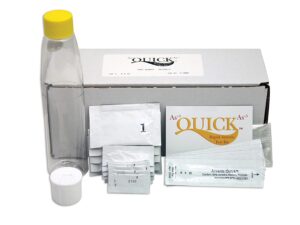
Chromated copper arsenate (CCA) is a pesticide containing chromium, copper, and arsenic and is used in treated lumber. CCA protects the wood against termites, fungi, and other pests that can degrade or threaten the integrity of wood products.
Chromated arsenicals have been used as wood preservative pesticides since the 1940s. In December 2003, CCA manufacturers discontinued manufacturing products for residential uses.
EPA – Environmental Protection Agency does not require the treated wood and soil to be removed. Use this Q and A to learn about CCA disposal and other valuable information.
Arsenic-treated wood results from a chemical process in which wood is treated with a pesticide/preservative called chromated copper arsenate (CCA). The chemical helps prevent rotting in lumber designed for outdoor use. CCA contained arsenic, chromium, and copper and was widely used for residential purposes in the United States from the 1970s until the U.S. Environmental Protection Agency (EPA) phased it out in 2003.
No – it’s not a good idea to burn a 20-year-old treated wood. The smoke and ash could be toxic. In Mississippi, treated lumber may be disposed of in a lined landfill. See more from the MS Dept of Environmental Quality (MDEQ).
Read the tag. Look for it on the end of the lumber. It will smell like oil or a chemical. Because of the chemicals, the lumber might be a tad larger than regular-sized wood. The color might help determine if it’s treated; it might be greenish, brown, tan, or olive. Use a swipe test. Find a kit here.
A treated 4×4 will last 20 to 25 years in the ground if the conditions in the soil and climate are favorable. That number could increase to 40 to 75 years if you install the treated 4×4 in a cement ring rather than the soil.
Avoid harsh cleaning products in CCA-treated wood, such as bleach, sodium hydroxide, percarbonate, oxalic acid, and citric acid. Never cut, sand, or power wash old-treated lumber. To reduce potential exposure to chemical residues, apply an oil- or water-based penetrating coating (stain, sealants).
Each piece of pressure-treated wood should carry a tag affixed to the end of the lumber. The tag’s information will help guide the lumber’s usage.
UC1 – Interior Dry. For treated wood products used in interior construction that are dry and will not be in contact with the ground or exterior weather. Their common hazard of deterioration is insects such as termites.
UC2 – Interior Damp. For treated wood products used in interior construction, it may be subject to some moisture but not in contact with the ground. The common hazards of deterioration are decay, fungi, and insects.
UC3A – Exterior above ground. Treated wood products used in exterior construction that are coated may be exposed to the full effects of the weather and not in contact with the ground. The common hazards of deterioration are decay, fungi, and insects. Application examples: Siding, trim, porches, and fascia.
UC3B – Exterior above ground. For treated wood products used in exterior construction that are uncoated and not in contact with the ground. The common hazards of deterioration are decay fungi, insects, and prolonged weather exposure. Application examples: Decking, joists, walkways, and railings.
UC4A – Ground contact. For treated wood products used in construction that are in contact with the ground, freshwater, and other general use. The common hazards of deterioration are decay, fungi, and insects. Application examples: Fence posts, structural lumber and timber, utility posts, and deck posts.
UC4B – Ground contact. For treated wood products used in construction that are in contact with the ground for heavy-duty use, such as severe environments with a high potential for deterioration. The common hazards of deterioration are decay fungi, insects, and biodeterioration from saltwater. Application examples: Wood foundations, utility poles, piers, and docks.
UC4C – Ground contact. For treated wood products used in construction that are in contact with the ground for extreme duty use, such as very severe environments with an extremely high potential for deterioration in critical structural components. The common hazards of deterioration are decay fungi, insects, ongoing exposure to weather, and extreme biodeterioration from saltwater.
UC5A – Marine use. Treated wood products used near or in salt and brackish northern coastal water are used in marine construction. The common hazards of deterioration are marine wood boring organisms, salt kill, and tidal water. Application examples: pilings, bulkheads, and piers.
UC5B – Marine use. For treated wood products used in marine construction near or in salt and brackish central coastal waters. The common hazards of deterioration are marine wood boring organisms, salt kill, and tidal water. Application examples: pilings, bulkheads, and piers.
UC5C – Marine use. For treated wood products used in marine construction near or in salt and brackish southern coast and gulf coast waters. The common hazards of deterioration are marine wood boring organisms, salt kill, and tidal water. Application examples: pilings, bulkheads, and piers.
UCFA – Interior fire protection. For treated wood products used in interior construction, fire protected and is not in contact with the ground or exposed to exterior weather. The common hazards of deterioration are fire. Application examples: roof trusses, joists, and paneling.
UCFB – Exterior fire protection. For treated wood products used in interior construction, fire protected and is not in contact with the ground but may be exposed to full effects of weather. The common hazard of deterioration is fire. Application examples: vertical exterior walls, roof surfaces, and other drainage system surfaces.
- - - - - - - - - - - - - - - - - - - - -